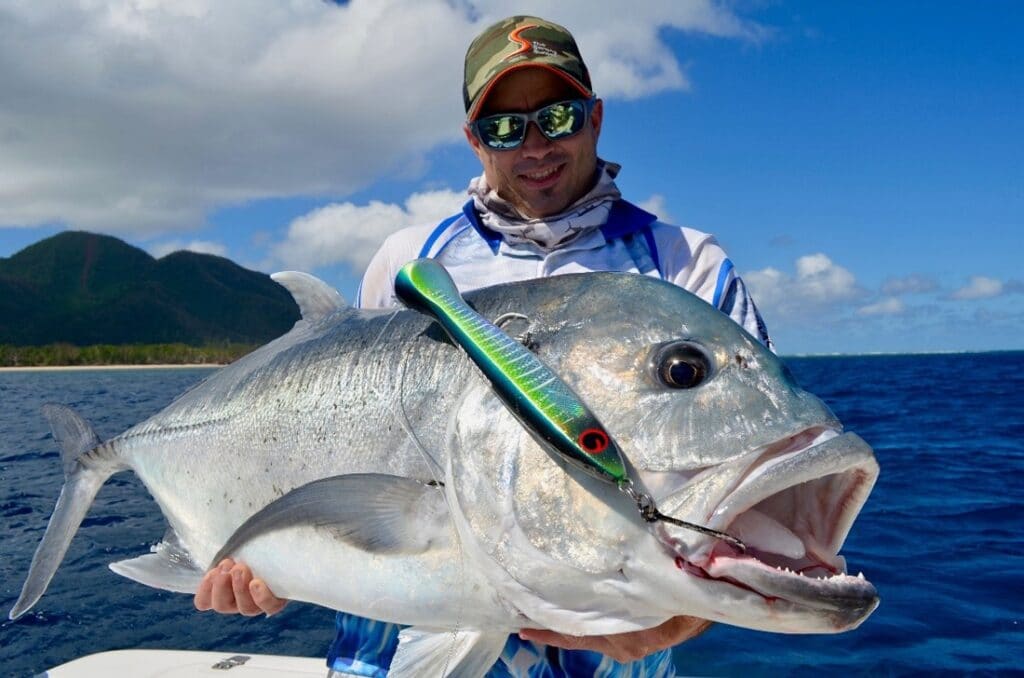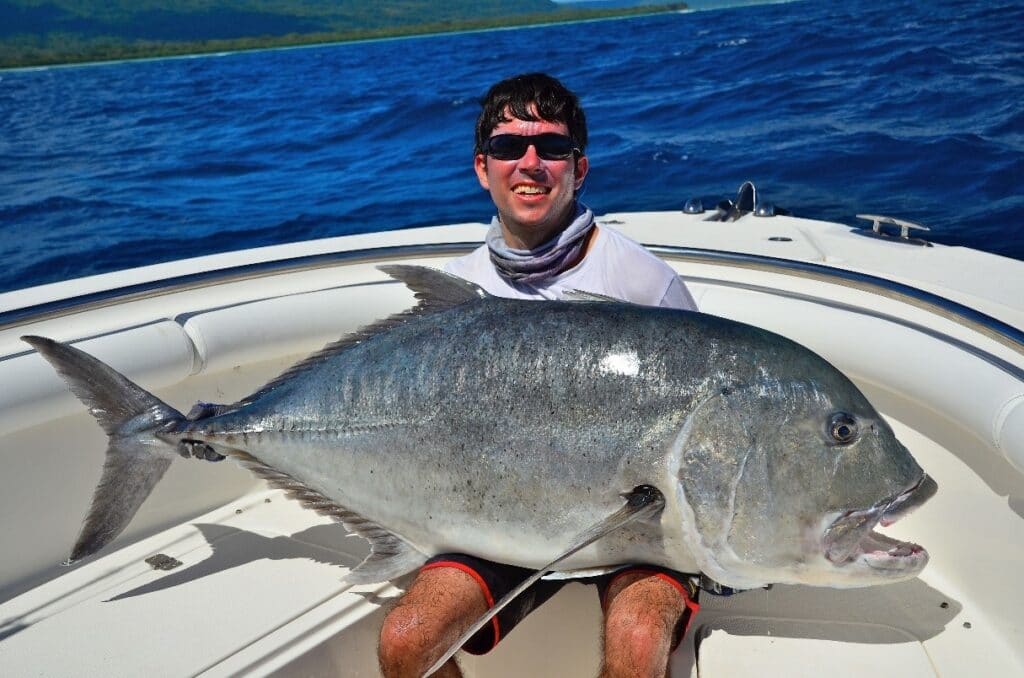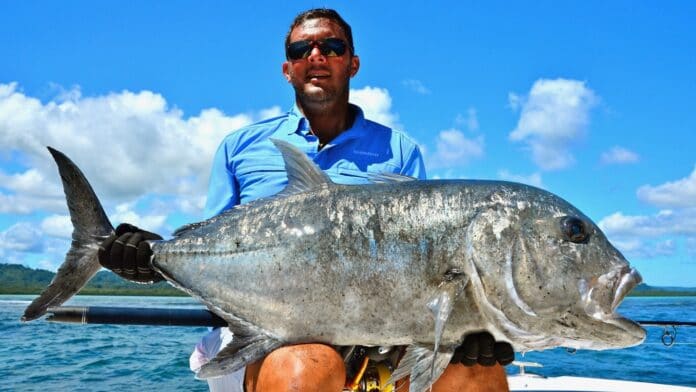Known as the reef gangster, gangster of the flats, the bully, the GEET, and among many other names, the Giant Trevally or Caranx ignobilis have been on top of the topwater fisherman’s “to catch” list for decades. They are insanely aggressive predators and can cause havoc and destruction on gear and angler alike. A well prepared body and mind are required to tangle with these bullies of the reef.
Even sharks are scared of them. They are a phenomenal fish to catch.
– Wayne Haselau (GT fly fishing ambassador)
Learn more about this wonderful species by reading on below.

Why The Giant Trevally Is Such A Good Catch
The Giant Trevally would be ranked number one amongst the top of serious fishermen’s hitlist. Taking poppers and stickbaits with serious aggression, causing insane topwater explosions, geets can cause a serious knee rattling experience.
The GT reaches its full size at 3-4 years which is a fast growth rate compared to other sport fish available in our waters. They have been recorded with a length of 170 cm long (5.577 feet, or 1.7 meters) and a weight of 80 kg (176.4 pounds). A serious combatant in the saltwater fishing arena.
Where Can You Find Them
The distribution of the Giant Trevally occurs in the tropical or coastal areas of the Indian and Pacific Oceans. The range extends from the eastern coast of Africa, along the coasts of India and Pakistan, across the coast of northern Australia, to as far east as Hawaii. Its habitat is in the shallow coral reefs and lagoons and channels in these tropical areas. Luckily enough, Vanuatu offers some of the best structure, bait and reef habitats that GTs love to call home so a trip with Ocean Blue Vanuatu can give you chances of hooking up to a monster geet.
They share their homes with Dogtooth Tuna, Napoleon Wrasse and large groupers, along with different shark species so be ready to get some by-catch when targeting this wonderful species.
How To Effectively Catch a Giant Trevally
To match its notorious reputation, geets require big gear and big terminal tackle. Targeting them on topwater using poppers and stickbaits is the most popular and we can say that there may be nothing else that can give us fishos an adrenaline pumping hit like a geet. PE6 -PE8 rods matched to size 14000 – 18000 reels are the best to use, but prepare to upsize your outfit to PE10 if you find the 60kg ~ class fish. There are insane amounts of fishing lures available to purchase that will work on geets. Know more about fishing lures here.
Casting towards visible or sunken structure pummeled by strong currents is the most effective. Current is the key word here and when there is no run, there is no fun. Predatory fish are quite “lazy” and will hang around areas very close to but unaffected by the strong current. This allows them to pick off any bait that is fazed after being caught in the strong current, allowing them to spend the least amount of energy for a feed. The bigger specimens hold deeper and further away from visible structure so target reefs with deep drop offs, or current channels that you may mark on your sounder while looking for bait.
When using poppers, strong pops are the key. Get as much surface disturbance as humanly possible. Different poppers have different characteristics so utilize their ability well. Chuggers chug, while splashers will make big waterfall like splashes. As long as there is a noticeable surface disturbance, it will get them angry and will cause them to aggressively hit your poppers.
Stickbaits on the other hand requires a bit of finesse. Different plugs will swim differently and require different retrieve styles, but a smooth sweeping retrieve will be the norm. Watch your stickbait at all times when sweeping your rod to see what kind of sweep length and strength works well for your lure. A trick I use is to get into a “zen” mode while watching my lure swim, giving myself a hypnotizing effect. This will get allow you to focus on the making the most out of your lure and keep your mind away from “expectations” of a strike. You’ll get hit when you least expect it. Trust me.
Lastly, one of the most effective surface plugs are the surface skippers, I.E. GT Icecream, Orion Flapper, and Adhel Young Lady. These are the easiest to use and sometimes extremely effective especially for the beginners. Cast as far out as you can, as close to the structure you intend to hit, then put your rod butt in your gimbal, keep your rod tip high, then crank fast to where your plug just skips and dances on the surface of the water. No need for sweeps and pauses here.
Cast and work your lures as much as you can. The more your lure is in the water working for a bite, the bigger the chances of you hooking up. And once you get a hit, set the hook hard! You need a strong and solid hookset to get the big treble hooks through the GT’s thick jaw flesh. Don’t give them a chance to reef you, always keep your drag and line tight and fight them like it’s the last fish you’ll catch in your lifetime. You never can tell if it’s a 50kg class fish or bigger.Contact our booking and reservations team to find out when is the best time to visit Ocean Blue Fishing Adventures and Trees and Fishes Resort to hook up to these gangsters of the reef. The team will bring you to the hottest current breaks and drop offs for the best chances of catching a Giant Trevally.

